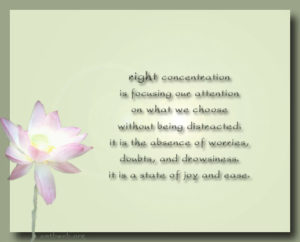
By John M. de Castro, Ph.D.
“So where do we begin if we want to improve our work life for ourselves and those around us? I suggest starting with the mind. Ask yourself: what is the quality of my mind at work? What’s happening in my mind as the hours at work go by day in and day out? Is my mind working at its utmost? . . . . Through mindfulness, we can train our minds to work better.” – Tara Healey
The work environment as an excellent context in which to practice the Buddha’s Eightfold Path. It is filled with interpersonal interactions and clashes, task focusing, dealing with authority, frustrations, successes, self-worthiness, and emotionality. In other words, the work environment has all the ingredients to put to the test all the principles of mindfulness and the Eightfold Path for the cessation of suffering; Right View, Right Intentions, Right Speech, Right Actions, Right Livelihood, Right Effort, Right Mindfulness, and Right Concentration.
We often think of meditation or spiritual practice as occurring in quiet places removed from the hubbub of life. This is useful to develop skills and deep understanding. Unfortunately, most people do not have the luxury of withdrawing into a solitary or monastic life. Fortunately, it is possible to practice even in the midst of the chaos of everyday life. In fact, there are wonderful opportunities to practice presented to us all the time embedded in the complexities of the modern world. In a previous essay we discussed driving an automobile as an almost perfect venue for practice. In today’s essay we’ll discuss practicing in the work environment.
There are many wonderful opportunities at work to practice Right View. The view that all things are impermanent can be practiced. Indeed, the situation at work is constantly changing and no matter how bad or good the work conditions or the daily experiences are you can be sure that they’ll change; the business cycle is constantly changing as are the people you work with and for. By recognizing this we not only practice Right View but also relax and accept what is. Work is a cooperative venture. It’s a situation that reflects how interconnected everything is including the thing we label self. Working without consideration of our superiors or co-workers and their needs and aspirations would be chaotic and very unproductive. How you work effects how they work and vice versa. In this context if you take a moment to look, it is easy to develop Right View including the transitoriness of our thoughts and emotions. At work they arise and fall away in response to the ever changing experiences occurring at work and your reactions to them. This thing called self that you think of a permanent and static actually changes moment to moment in reaction to these experiences at work. This is a tremendous learning experience with work being a wonderful laboratory to practice and develop your Right View.
It is hard to find a better context than working to develop the Right View on suffering and unsatisfactoriness, and their roots. While working we seem to want everything to be exactly as we want it to be, and when it isn’t we suffer. We want meetings to be short, incisive, and productive, we want technology to always be working properly, we want to always be recognized for our efforts and accomplishments, we want less dull repetition and paperwork, we want our co-workers to be cooperative rather than competitive, we want a raise, we want a promotion, we want our bosses to always make the right decisions, we want everyone to like us, etc. When these things don’t happen, we suffer. In other words, you can learn, if you are observant of what is happening during working, that your suffering is caused by your lack of acceptance of how things are at work. So, working constitutes a wonderful laboratory to practice Right View. You can learn to accept things as they are, to see things without judgment, to view the job, your bosses, and other workers just as they are, and to understand how you work has consequences, affecting yourself and others, in other words, you practice and develop Right View.
You can quite readily practice Right Intentions while working and this can lead to Right Actions. These intentions include the abandonment of unwholesome desires. If you work with anger, impatience, selfishness, resentment you are likely to harm others and yourself. The harm may not be major or direct, but indirect by affecting the other workers in negative ways. Perhaps your anger at an unsatisfactory work situation causes the intentional sabotage of a project. Perhaps, your selfishness causes you to refuse to help a struggling co-worker eliciting frustration or worry about the security of their job, or simply cause them to suffer. But sometimes direct harm to others can be produced by greed resulting in your undercutting or obstructing their work in order to make yourself look better and step over them for promotion. But if you practice Right Intentions with sincere intentions to create good and happiness, relieve suffering in ourselves and others, and not harm any living thing, you will work cooperatively, with courtesy, with tolerance and understanding, with kindness and good will. When co-workers are treated with respect, compassion, and helpfulness or when a co-worker’s anger or frustration are reacted to with patience, kindness, and tolerance, harm and suffering have likely been prevented. It is good to reflect on the ripples of good that may have been created with Right Actions producing positive consequences, which produce more positive consequences, producing more positive consequences, etc. well into the future.
Intentions are a key. They become your moral compass. They tend to lead you in the right direction even though you may at times stumble. It is often difficult or impossible to predict all of the consequences of your actions. It is also very difficult not to create some harm. You have to consider that your competitive success may be causing others to lose their jobs, or that the manufacturing processes you’re using compromises the natural environment, or that trying to minimize costs, you use suppliers who employ people at less than a living wage. You need to try to not only have Right Intentions, but to discern how even the best of intentions can sometime produce harmful outcomes. You have to sometimes balance the good you’re doing with the harm produced by the same actions. This requires Right View. This is where working can be such a great practice as you can learn what works and what doesn’t and become better at discerning what are the wholesome Right Actions from those that produce more harm than good. But, if you form Right Intentions and aspire to create good and happiness you’ll be a better worker and will produce more harmony and good will in the work place and more importantly will be moving yourself along the eightfold path.
There are many opportunities to practice Right Speech while working. This can include non-verbal communications such as facial expressions, body postures, etc. But, predominantly Right Speech is verbal. A worker may have a bad habit of often reacting to a mistake with reflexive emotional expletives. This can occur in response to something as simple as dropping a part, to another worker’s dangerous actions. This can also include gestures. They do no good and create harm in myself and sometimes aggravate and harm others. Office gossip is rampant in the work environment. This often hurts others in unpredictable and sometimes unknown ways. Right speech involves refraining from gossip. At work frequently guesses and rumors are spread. Right Speech involves only speaking things that you know are absolutely true. This can promote trust and harmony in the workplace. By practicing Right Speech you can work toward alleviating the suffering produced in ourselves and others. Simply react, rather than with expletives, with words such as “be safe” or a silent recitation of the loving kindness meditation wishes for health, happiness, safety etc. Right Speech takes practice. We have years of training and daily multiple examples of wrong speech. So, be patient and practice. Slowly the effects and benefits will become apparent.
The notion of Right Livelihood mandates that your work not only earns you a living but also creates greater happiness, wisdom, and well-being, and relieves suffering in yourself and others. Conversely, you should not produce harm. This doesn’t discourage earning profits and accumulating wealth. It simply indicates that it must be done in the right way. It indicates that you should acquire wealth only by legal means, peacefully, without coercion or violence; you should acquire it honestly, not by trickery or deceit; and you should acquire it in ways which do not entail harm and suffering for others. Some occupations can be clearly seen as creating harm such as manufacturing, selling, or delivering weapons, cigarettes, or harmful drugs, or driving animals to slaughter. Some occupations clearly seem to create greater good and happiness, such as teacher, aid worker, nurse, etc. But, most occupations are a little more difficult to tell. Sometimes harm is produced indirectly, such as by damaging the environment, or resulting in layoffs from a competitor, or by producing goods or services that can be misused or used by others to create harm. It is not yours to judge the “rightness” of other people’s occupations. This is a personal matter where intention matters, that must be reflected upon deeply to ascertain whether your practicing Right Livelihood.
Once again, working presents a great context to practice Right Effort. It takes substantial effort to work mindfully. If you work automatically as most people do most of the time, there is little or no mindfulness and little or no effort. When you first get to work you have to set the intention to engage in your work in such a way as to lessen suffering in yourself and others, to work with kindness, compassion, patience, and courtesy, to drop fear, anger, hatred, selfishness, and the survival of the fittest attitude, and to bring to our interactions with others at work the intention to promote well-being and happiness. Right Effort is working the “Middle Way.” That is not trying too hard and getting stressed about working mindfully, and also not being lackadaisical, but rather to try, but relax. Don’t beat yourself up when you’re not working mindfully, but congratulate yourself when you do. The “Middle Way” is where effort should be targeted.
Mindless working is probably the norm. Most people perform their routine work activities while their minds are elsewhere, ruminating about the past, planning for the future, or off in fantasy and daydreams. This provides you with a terrific opportunity to practice Right Mindfulness. Jon Kabat-Zinn defined mindfulness as “paying attention on purpose, in the present moment, and nonjudgmentally, to the unfolding of experience moment to moment.” What better opportunity to practice this than while working? Right Mindfulness while working precludes focusing on social media or engaging in other distractions that detract from our efforts. Right Mindfulness makes you acutely aware of what is happening and how you’re feeling during every moment of your work. This makes not only for a more enjoyable work, but also for much better working. Awareness of how you’re feeling and what’s producing those feelings, and how you’re reacting to them makes you better able to work effectively without emotional outbursts that are non-productive and can damage the efforts of co-workers. Right Mindfulness while working is not just part of the eightfold path it is a prerequisite for the practice of the seven other components of the path. So, working mindfully is a fundamental practice and working is a great situation for practice.
Right Concentration is the practice of focusing the mind solely on one object or a specific unchanging set of objects. This is developed during contemplative practice such as meditation. It is essential to effective work. Very few people have the luxury of working in quiet isolated circumstances. Most work in environments that are replete with distractions and interruptions.
Improvement in attentional ability is a consequence of practicing Right Concentration improves focused attention on the work, reducing distractions and mind wandering. The ability to concentrate and screen out intrusive sounds, sights, speech and thoughts allow you to focus on your work, producing higher quality work while being more efficient and productive. In addition, it is thought that Right Concentration requires Right Effort, Right Intentions, and Right Mindfulness and these can also be practiced and developed while working. So, working is a wonderful situation for the practice of Right Concentration, benefiting the individual and the quality of the work.
Working the eightfold path is not easy. But, remember that it is a practice. Over time you’ll better and better at it, but nowhere near perfect. Frequently the discursive mind takes over or your emotions will get the better of you. But, by continuing the practice you’ll slowly progress. you’ll become a better worker and a more relaxed and happier worker. You then can leave work at the end of the day relaxed with a smile on your face rather than angry and stressed.
Through engaging in the eightfold path at can we achieve enlightenment? Probably not! But we can practice it and the Buddha taught that it leads there. The strength of practicing the eightfold path at work is that it occurs in the real world of our everyday life. Quiet secluded practice is wonderful and perhaps mandatory for progress in spiritual development. But for most people it only can occur during a very limited window of time. By extending the practice directly into the mainstream of our lives we can greatly enhance its impact. Keep in mind the teaching that actions that lead to greater harmony and happiness should be practiced, while those that lead to unsatisfactoriness and unhappiness should be let go. Without doubt, practicing the eightfold path at work leads to greater harmony and happiness and as such should be included in our spiritual practice.
“As an executive coach and physician, I often sing the praises of mindfulness approaches and recommend them to clients to manage stress, avoid burnout, enhance leadership capacity, and steady their minds when in the midst of making important business decisions, career transitions, and personal life changes.” – David Brendel
CMCS – Center for Mindfulness and Contemplative Studies
This and other Contemplative Studies posts are also available on Google+ https://plus.google.com/106784388191201299496/posts









